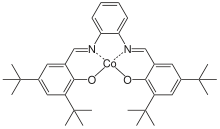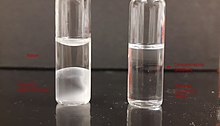Polypropylene glycol

| |
| Names | |
|---|---|
| IUPAC name
[specify]
| |
| Identifiers | |
| |
ECHA InfoCard
|
100.105.547 |
| UNII | |
CompTox Dashboard (EPA)
|
|
| Properties | |
| C3nH6n+2On+1 | |
| Molar mass | 58.08n + 18.08 (repeat unit), mass of polymer variable |
Except where otherwise noted, data are given for materials in their standard state (at 25 °C [77 °F], 100 kPa).
| |
Polypropylene glycol or polypropylene oxide is the
Polymerization
Polypropylene glycol is produced by

Conventional

Properties
PPG has many properties in common with polyethylene glycol. The polymer is a liquid at room temperature. Solubility in water decreases rapidly with increasing molar mass. Secondary hydroxyl groups in PPG are less reactive than primary hydroxyl groups in polyethylene glycol. PPG is less toxic than PEG, so biotechnologicals are now mainly produced with PPG.[4][5][6]

Uses
PPG is used in many polyurethane formulations.[7][8] Synthesis of waterborne polymers has been a feature with this substance.[9] As the basic building block is propylene oxide, there are 3 carbons per oxygen on the backbone. This confers some degree of water miscibility though not as good as ethylene oxide based molecules.[10] It is used to synthesize the epoxy reactive diluent and flexibilizer, Poly(propylene glycol) diglycidyl ether.[11][12] Another use of PPG is as a surfactant, wetting agent and dispersant in leather finishing.[13] PPG is also employed as a reference and calibrant in mass spectrometry and HPLC.[14][15] PPG and derivatives maybe used as defoamers in drilling and other applications.[16][17] It is also used as a primary ingredient in the making of paintballs.[18] It has been evaluated as a corrosion inhibitor.[19]
References
- ^ "2-(2-Hydroxypropoxy)propan-1-ol". PubChem. U.S. National Library of Medicine. Retrieved 2022-11-14.
- ISBN 978-3527306732.
- PMID 16104709.
- PMID 26947804.
- PMID 23030523.
- S2CID 213206957.
- ISSN 0300-9440.
- S2CID 225563251.
- ^ US 10920011, Kim KJ, Hu R, Grove JL, "Water soluble polymers and polymer adducts along with aqueous solutions thereof Patent", issued 16 February 2021, assigned to Arkema Inc
- ^ Howarth GA (April 1997). Synthesis of a legislation compliant corrosion protection coating system based on urethane, oxazolidine and waterborne epoxy technology (Master of Science thesis). London: Imperial College. pp. 36–28, 52–60.
- ISSN 0887-624X.
- ^ US 5162547, Roth M, Wolleb H, Truffer MA, "Process for the preparation of glycidyl ethers", published 1992-11-10, assigned to Ciba-Geigy Corp.
- PMID 16343594.
- PMID 14735971.
- ISSN 0956-053X.
- ISSN 0892-6875.
- .
- S2CID 218923617.
- ISSN 0369-9420.
